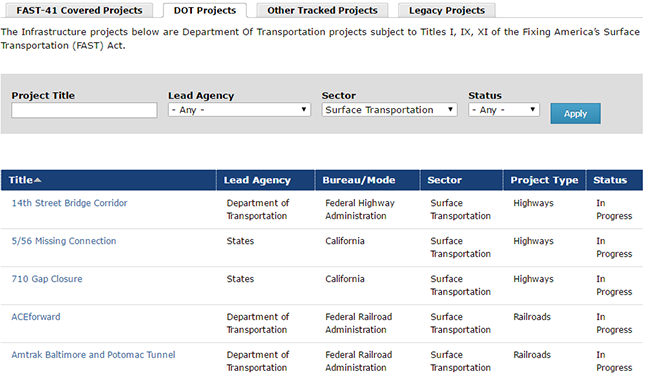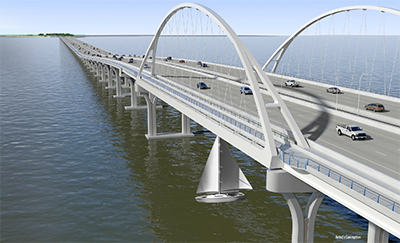
Federal Permitting Dashboard Helps FHWA Accelerate
Environmental Reviews, Improves Communication with the Public
The U.S. Department of Transportation (DOT) and the White House Office of Management and Budget (OMB) and Council on Environmental Quality (CEQ), have been collaborating on initiatives that modernize the Federal government’s role in the permitting and environmental review of proposed infrastructure projects. One such initiative is the Federal Permitting Dashboard (Dashboard), an online tool for Federal agencies, project developers, and the public to track the Federal government’s permitting and review process for large and complex infrastructure projects. The primary objectives of the Dashboard are to increase transparency and to shorten review timelines while improving environmental and community outcomes. The Dashboard achieves these objectives by encouraging early coordination and synchronization of agency review schedules.
This issue discusses the following information about the Dashboard:
- The Dashboard purpose and functions;
- Legacy Dashboard projects in New York and Florida; and
- The overall benefits of tracking project delivery with the Dashboard.
Dashboard Improves Accessibility to Information FHWA Regularly Collects
The Dashboard offers access to more stakeholders interested in tracking the progress of projects. The Dashboard, which is managed by DOT and OMB, is a mechanism for accelerating project reviews while improving environmental outcomes. With the enactment of the Fixing America’s Surface Transportation (FAST) Act on December 4, 2015, Federal Highway Administration (FHWA) is required to input all Environmental Impact Statements (EISs) and certain Environmental Assessments (EAs) into the Dashboard. CEQ and OMB published updated guidance that reflects changes made by the FAST Act.
The Dashboard was initially used to highlight and track a small group of projects that represented a sample of the types of projects pursued. The majority of these legacy projects has completed their environmental review and permit processes, some years ahead of schedule. FHWA monitored those legacy projects and continues to populate the Dashboard with surface transportation projects under development nationwide. FHWA collected data on and monitored projects before the Dashboard was established using an internal database known as the Environmental Document Tracking System (EDTS). In 2013, FHWA integrated the EDTS into the Project and Program Action Information System (PAPAI) to continue to track environmental milestones and other project actions.

The Dashboard includes a tab for DOT Projects where users can find information on projects and their status. (Courtesy of U.S. DOT)
As DOT and OMB continue to refine the Dashboard, the FHWA Office of Project Development and Environmental Review (HEPE) is working to update projects in the Dashboard using information input by FHWA Divisions via PAPAI. This should continue to enhance coordination and communication among State DOTs, FHWA Division Offices, and HEPE. FHWA now enters project schedules, milestones, and other details gathered in PAPAI into the Dashboard, so the information is accessible by other agencies, project developers, and the public.
NEPA Assignment States Are Responsible for 23 U.S.C. 139 Compliance
States that have assumed project-level National Environmental Policy Act (NEPA) responsibilities under the Surface Transportation Project Delivery Project (23 U.S.C. § 327) are required to supply project development and compliance status updates for all applicable projects to the Secretary of Transportation. These States are required to enter that information directly into the Dashboard.
Dashboard Legacy Projects Demonstrate Accelerated Project Delivery Successes
As of March 2017, the Dashboard includes more than 150 projects, about 90 percent of which are currently in progress. The Dashboard includes a separate list of legacy projects, which are infrastructure projects that were part of the original Dashboard hosted on Max.gov. About 67 percent of these projects are complete. Several legacy projects are under the purview of FHWA and provide important lessons learned on how to successfully accelerate project development and environmental review. Two such projects are the Pensacola Bay Bridge, which is in progress, and the Tappan Zee Bridge, which is complete.
Pensacola Bay Bridge
The Florida Department of Transportation (FDOT) proposed replacing the Pensacola Bay Bridge, which carries State Route 30 (US 98) across Pensacola Bay, connecting downtown Pensacola with the city of Gulf Breeze. Various alternatives and alignments were considered under the project development and environmental study phase to address both safety and capacity improvements to the bridge that would tie into existing facilities. FHWA, FDOT, and the US Coast Guard (USCG), which is a cooperating agency since the bridge is located in U.S. navigable waters, coordinated on the NEPA document and USCG navigation requirements.
Built in 1960, the three-mile long Pensacola Bay Bridge is structurally deficient, requiring FDOT to plan for a replacement bridge within the next three to five years. The objective of the environmental study was to provide documentation and information necessary for FDOT to reach a decision on the feasibility, location, and conceptual design of a replacement for the existing bridge. Analyses covered current and future traffic demand, social impacts, environmental impacts, community values, aesthetic considerations, and engineering principles. FDOT applied its Project Development and Environment (PD&E) process to the project, ensuring NEPA requirements were met and documentation was advanced to design, environmental permitting, and construction without delays. The PD&E process combined with FDOT’s design-build process saved FDOT time and resources.

A rendering of the new Pensacola Bay Bridge. (Courtesy of FDOT)
Throughout the study, a comprehensive public involvement program provided opportunities for local, state, and Federal agencies and elected officials to provide input into the development of the bridge replacement alternatives. A project website providing information on upcoming meetings, schedules, and project documents was available throughout the study process. FDOT also utilized its agency liaisons at USCG, the U.S. Army Corps of Engineers, the U.S. Fish and Wildlife Service, and the National Marine Fisheries Service to ensure stakeholders were involved and coordinated with regularly. The Dashboard helped all state and Federal partners establish and monitor target dates throughout the process.
Ultimately, the study findings, including an EA required by NEPA, were documented and submitted to FHWA for approval of the location and design concept for the replacement bridge. The final EA is available on the Dashboard. Various environmental consultations and public meeting information are also available on the Dashboard, and several planned permitting processes are scheduled to be completed in 2017. A Finding of No Significant Impact (FONSI) was completed, but proposed design changes triggered a re-evaluation as required by 23 CFR 771.129. FDOT obtained NEPA Assignment after the FONSI was completed, so further NEPA actions will not require FHWA review and approval.
Tappan Zee Bridge
Benefits of Accelerating Project Delivery
- Created jobs
- Reduced permitting time
- Completed the project early
- Strengthened partner relationships
- Improved agency accountability
The Tappan Zee Bridge was originally built in 1955, and though it has remained safe to the public since that time, it did not meet current efficiency standards for design or traffic operations as of a few years ago. Over the last 30 years, traffic volumes on the bridge have grown by almost 30 percent, and more than 138,000 vehicles cross the bridge each day. The Tappan Zee Bridge Replacement project was selected to undergo accelerated permitting and review because of the vital links it provides to regional and national transportation networks.
The Tappan Zee Bridge Replacement project was an ideal candidate for accelerated review because of the safety, operational, mobility, and structural needs it addresses for the region. As a major route for freight movement between points east and west of the Hudson River, the Tappan Zee Bridge is the primary roadway connection between New England and the Port of New York and New Jersey. The bridge provides the only interstate highway crossing of the Hudson River for a 48-mile stretch between the George Washington Bridge in New York City (I-95) and the Newburgh-Beacon Bridge (I-84).
For a project with such a large scope and environmental setting, the number of approvals required to begin design and construction was substantial. The complex scope and important transportation needs identified above led FHWA to determine that the project would benefit from accelerated permitting and environmental review. This was achieved by: (1) coordinating concurrent reviews and approvals among the partner agencies; (2) establishing comprehensive schedules to ensure each step in the process was properly completed; and (3) integrating environmental reviews, permitting, and consultations. The permitting process was completed in 2013, so the Dashboard now serves as a repository for all of the documentation required for the project. For more information on how New York and its partners accelerated the project development and environmental review of the Tappan Zee Bridge, read the February 2016 issue of this newsletter.
Permitting Reforms Improve Government Efficiency, Protect Public Interest
For projects that are particularly large and complex or that have significant environmental impacts, the permitting and environmental review process can be lengthy and complex. The Dashboard is helping to move these large infrastructure projects through environmental review and permitting processes as efficiently as possible. This should help communities to more quickly realize benefits such as reduced traffic, additional construction jobs, and increased economic activity, while protecting public health, safety, cultural resources, and the environment.
The Dashboard creates a more transparent environmental process and facilitates the collaborative techniques necessary to accelerate project delivery and achieve improved environmental and community outcomes. It also provides the data necessary to identify timeframes associated with environmental reviews and allow FHWA and other Federal agencies to measure the effectiveness of reform efforts.
Contact Information
David Williams
Office of Planning, Project Development & Environmental Review
Federal Highway Administration
David.Williams@dot.gov
202-366-4074
Successes in Stewardship is a Federal Highway Administration newsletter highlighting current environmental streamlining and stewardship practices from around the country. Click here to subscribe, or call (617) 494-3719 for more information.

